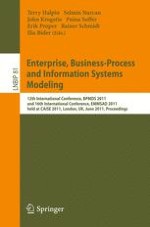This book contains the refereed proceedings of the 12th International Conference on Business Process Modeling, Development and Support (BPMDS 2011) and the 16th International Conference on Exploring Modeling Methods for Systems Analysis and Design (EMMSAD 2011), held together with the 23rd International Conference on Advanced Information Systems Engineering (CAiSE 2011) in London, UK, in June 2011.
The 22 papers accepted for BPMDS were selected from 61 submissions and cover a wide spectrum of issues related to business processes development, modeling, and support. They are grouped into sections on BPMDS in practice, business process improvement, business process flexibility, declarative process models, variety of modeling paradigms, business process modeling and support systems development, and interoperability and mobility.
The 16 papers accepted for EMMSAD were chosen from 31 submissions and focus on exploring, evaluating, and enhancing current information modeling methods and methodologies. They are grouped in sections on workflow and process modeling extensions, requirements analysis and information systems development, requirements evolution and information systems evolution, data modeling languages and business rules, conceptual modeling practice, and enterprise architecture.
